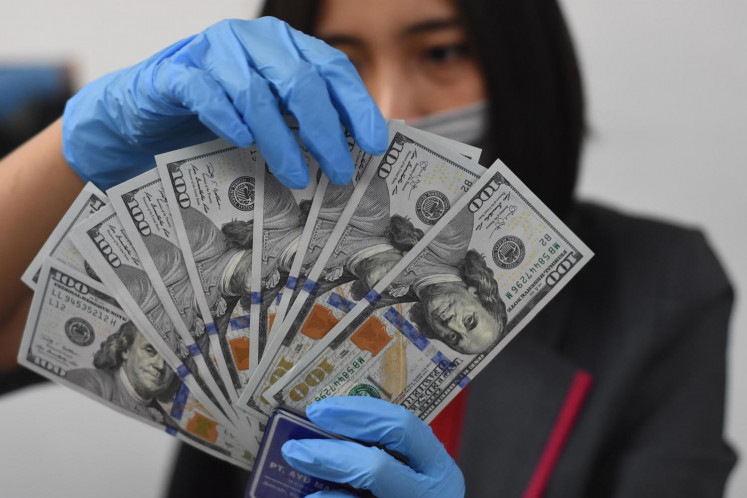Jakarta Fashion and Food Festival, A celebration of local culture
The looming global financial crisis might be the right reason to investigate local culture and environmentally friendly fashion, as they got along pretty well at the Jakarta Fashion and Food Festival held between May 13 and May 23 in Kelapa Gading, North Jakarta
Change Size

The looming global financial crisis might be the right reason to investigate local culture and environmentally friendly fashion, as they got along pretty well at the Jakarta Fashion and Food Festival held between May 13 and May 23 in Kelapa Gading, North Jakarta.
The annual festival showcasing the works of 55 designers from Association of Indonesian Fashion Designers and Entrepreneurs (APPMI) and the Indonesian Fashion Designer Council (IPMI) used "Locafore" as its tagline.
Locafore, a philosophy about using eco-friendly and locally made products, has encouraged most designers to bring various Indonesian traditional fabrics into the spotlight.
The fashion show itself was divided into three sequences: "Vis * vis", "Encore" and "Heavenly Touch". "Vis * vis", which literally means "face to face", displayed cocktail dresses; "Encore", a French word for "again", was all about evening wear and "Heavenly Touch" showed the new breed of Islamic clothing.
During the Vis * vis sequence, designer Dina Midiani brought environment friendly fashion with her Wounded Forest collection. She merged used tulle, cotton, batik and woven fabrics into one, applying a cut and brush technique to create the casual artistic look.
The whole collection had brownish nuances with splashes of bluish grey and white to depict the burned forest.
Designer Uke Toegimin conveyed the West Borneo "Chastity" theme by combining West Kalimantan tribe Dayak beadcraft with West Kalimantan pattern printed chiffon. The stiff beadcraft, which was made into mini skirts, was combined with loose shirts. Beadcraft also appeared as belts and other accessories.
Designer Oki Wong used North Sumatra weavings, called Batubara weaving, for his Rhythm Nation collection.
The Batubara weaving was applied for bustier and A-line dresses and combined with taffeta, raw silk, damask and chiffon.
For the Encore sequence, most designers, such as Anne Avantie, Agnes Budhisurya, Ayok Dwi Pancara, Joko Sasongko and Zaenal Songket, took inspiration from the national dress, kebaya, and combined it with traditional fabrics from Java, Sumatra and Kalimantan.
Traditional fabric with a modern touch came from designer Poppy Dharsono, who used Lasem batik for her "Stormy in Lasem" theme. Lasem batik has a unique pattern and colors, especially the chicken blood-red color that can not be imitated by batik artisans in other areas.
Lasem handmade batik, which is difficult to find nowadays, is a melting pot for the culture of Chinese, northern coast and Javanese palaces (Surakarta and Yogyakarta). The Chinese influence can be seen through the patterns of phoenix birds and Chinese legendary lion-like animal qilin, the Javanese palace culture is shown through kawung and parang patterns, while the northern coast culture usually uses bright colors, like blue, green and yellow.
However, for her collection, Poppy used earthy natural colors and worked her Lasem batik into modern-ethnic clothing, with feminine and masculine touches.
During the Heavenly Touch sequence, designer Merry Purnomo introduced Mataram weavings in her "Cahaya Tenun Mataram" (The Light of Mataram Weavings) collection. Merry applied twists of the thick red, blue and green Mataram weaving as accents on the shoulder, waist, sleeves and skirt.
Meanwhile designer Nunik Mawardi offered unique Islamic clothing under her "Omorfprada" theme. "Omorfprada", the coined word of amorfa (Greek word for beauty) and prada (Balinese, golden pattern), displayed Grecian-look dresses with Balinese patterns.
Nunik took inspiration from the great architecture of the Greek golden era for the dresses' shapes as she created one-shoulder stoles, structured gowns and pleat details on the shirts.
As for the clothes patterns, Nunik adopted it from the famous Balinese black and white checkered pattern. But instead of using the usual colors, Nunik asked weaving artisans in Tuban, East Java, to apply Mediterranean colors of brick red, yellow and grey, resulting in a Scottish tartan-like design.
A celebration of local culture, the festival was a blossoming hope for a better future for the Indonesian fashion industry.









